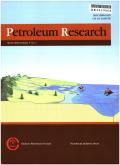Influence of stress sensitivity on pore structure of tight reservoirs: A Digital core based analysis
IF 4
Q1 Earth and Planetary Sciences
引用次数: 0
Abstract
During the development of tight reservoirs, as the formation pressure decreases, the effective stress on the rock matrix increases. This leads to rock deformation and, consequently, changes in the physical parameters of the reservoirs, affecting reservoir productivity. Therefore, it is crucial to identify the influence of stress variation on the pore structure of tight reservoirs at the pore scale. Based on 3D grayscale images of representative samples under different confining pressures using micrometer computed tomography, this study obtained corresponding 3D digital cores through binary segmentation using the maximum class spacing algorithm. Based on digital cores with the same physical size under different confining pressures, the binary data volume was subtracted using a Boolean algorithm to obtain the pore variation space under different confining pressures. The pore variation and permeability damage rate under different confining pressures were then determined. Pore network models of digital cores under different confining pressures were extracted using the maximal ball algorithm, and the corresponding pore-throat radius distribution, coordination number distribution, length/diameter ratio, and shape factor distribution were calculated. The results show that as the confining pressure increases, the pore-throat distribution curve shifts to the direction of smaller pore-throats, the average coordination number decreases, and the throat length/diameter ratio distribution curve and shape factor distribution curve shift to the direction of larger pore-throats. This is because compaction reduces pores and throats, decreases the overall pore-throat connectivity, narrows the throats, and makes the cross-sections of the pore-throats more circular. This research serves as a basic platform for efficient development under stress sensitivity in tight reservoirs, and its findings have important academic significance and practical application value.
应力敏感性对致密储层孔隙结构的影响——基于数字岩心的分析
在致密储层开发过程中,随着地层压力的减小,岩石基质上的有效应力增大。这会导致岩石变形,从而改变储层的物理参数,影响储层的产能。因此,在孔隙尺度上识别应力变化对致密储层孔隙结构的影响至关重要。本研究以不同围压下的代表性样品的微米ct三维灰度图像为基础,采用最大类间距算法进行二值分割,得到相应的三维数字核。基于不同围压条件下具有相同物理尺寸的数字岩心,采用布尔算法对二进制数据体进行相减,得到不同围压条件下的孔隙变化空间。测定了不同围压下的孔隙变化和渗透率损伤率。采用最大球算法提取不同围压条件下的数字岩心孔隙网络模型,计算相应的孔喉半径分布、配位数分布、长径比和形状因子分布。结果表明:随着围压的增大,孔喉分布曲线向较小孔喉方向移动,平均配位数减少,喉道长径比分布曲线和形状因子分布曲线向较大孔喉方向移动;这是因为压实减少了孔隙和喉道,降低了整体孔喉连通性,使喉道变窄,并使孔喉的横截面更圆。本研究为致密储层应力敏感条件下高效开发提供了基础平台,其研究成果具有重要的理论意义和实际应用价值。
本文章由计算机程序翻译,如有差异,请以英文原文为准。
求助全文
约1分钟内获得全文
求助全文
来源期刊

Petroleum Research
Earth and Planetary Sciences-Geology
CiteScore
7.10
自引率
0.00%
发文量
90
审稿时长
35 weeks
 求助内容:
求助内容: 应助结果提醒方式:
应助结果提醒方式:


